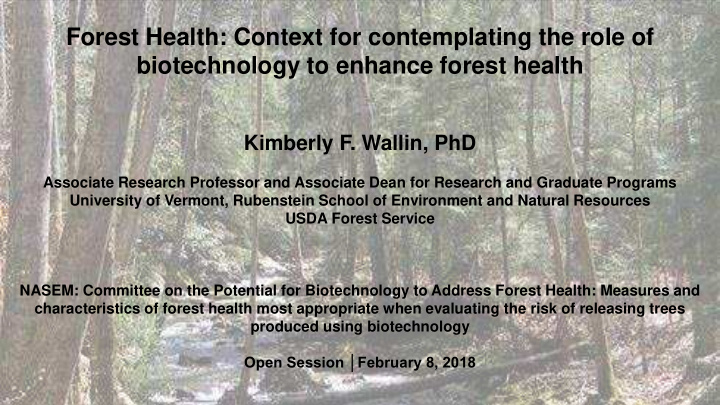



Forest Health: Context for contemplating the role of biotechnology to enhance forest health Kimberly F. Wallin, PhD Associate Research Professor and Associate Dean for Research and Graduate Programs University of Vermont, Rubenstein School of Environment and Natural Resources USDA Forest Service NASEM: Committee on the Potential for Biotechnology to Address Forest Health: Measures and characteristics of forest health most appropriate when evaluating the risk of releasing trees produced using biotechnology Open Session │February 8, 2018
Forest Health: It is everything and it is nothing
Forest Health: It is everything and it is nothing Forest health needs to encompass: • range of functions and services • management objectives and threats all present at a variety of scales. Due to the complexity of the forest health concept, no definition can be sufficient therefore, it is most appropriate to explicitly consider the above points when discussing the health of a forest.
Forest Health: Urban forests Urban forests consist of about 3.8 billion trees valued at $2.4 trillion.
Forest Health: Naturally regenerating forests Natural forest is a forest self-generated on the location and consists of naturally immigrant tree species and strains, and has not been planted.
Forest Health: Working landscapes Leaf-peeping in New England is worth over $5 billion annually (VT, NH, ME, MA, RH: Departments of Tourism)
Forest Health: Foundation species Unique forests that many species depend on for survival
Forest Health: Production Plantation forests show promise for biofuels in southern US (R. Gonzalez, J. Wright, D. Saloni)
Threats to forest health and management options Examples: 1) Invasive species pose threat on forest health 2) Range expansion of native species 3) Re-introduction of trees 4) Plantations
Invasive species pose threat on the health of forests, especially urban forests Photo credit: Ben Eastaugh and Chris Sternal-Johnson.
Invasive species pose threat on the health of forests, especially urban forests Ash trees in a Toledo, Ohio Ash trees in a Toledo, Ohio neighborhood in June 2006. neighborhood in June 2009. Credit: D. Herms Credit: D. Herms
Knowledge gap: Does biotechnology have a role to enhance urban forest health in the face of invasive species? • Maybe, but why invest in this strategy? • Probability of success is unknown • Probability of lasting effectiveness is likely low • Next pest is right around the corner
Knowledge gap: Does biotechnology have a role to enhance urban forest health in the face of invasive species? • Alternatively, learn from the past and increase diversity of urban trees. • Invest in this proactive management practice • Probability of success is high • Probability of negative impacts are low • Increase urban ecosystem diversity Bocana Street, in the Bernal Heights neighborhood of San Francisco
Knowledge gap: Does biotechnology have a role to enhance the health of forests as native species expand their range? Mountain Pine Beetle Southern Pine Beetle
Dendroctonus (Latin for tree killer )
Landscape level mortality caused by mountain pine beetle Over 18 million hectares in CN
Landscape level mortality caused by mountain pine beetle Over 34.5 million hectares in North America
Really good at locating host trees
Host Selection and Colonization Secondary host selection • Response to aggregation pheromones and host tree volatiles
Mountain pine beetle MPB girdle trees by cutting off the flow of water and nutrients In addition, MPB carries an fungus Grosmannia clavigera. This fungus cuts off the flow of water and nutrients in the tree
Overcome tree defenses!
Defenses: are they heritable? Ott, Yanchuk, Wallin. 2012.
Southern pine beetle are not just southern anymore Dendroctonus (Latin for tree killer ) Dodds, 2015
New Jersey pines killed within weeks by D. frontalis Photo by Bob Williams, Land Dimensions
Knowledge gap: Does biotechnology have a role to enhance the health of forests as native species expand their range? Maybe, but need to know, • What is the target? Host selection? Host defenses? • Probability of lasting effectiveness is likely low • Classic ‘arms race’
Knowledge gap: Does biotechnology have a role to enhance the health of forests as native species expand their range? • Alternatively, actively manage our forests • MPB: Increase age class and species diversity • SPB: Management program is the shining star of success in the history of forest pest management • Communicate methods across regions
Knowledge gap: Does biotechnology have a role to enhance the health of forests by reintroducing trees?
Knowledge gap: Does biotechnology have a role to enhance the health of forests by reintroducing trees? Probably, • Whitebark pine trees are expensive to propagate, add powerful tool to breeding repertoire. • Perhaps breed for tolerance to warming winters. • The American Chestnut Foundation values each B3F3 seed at $250 (Schaberg), biotechnology could increase return on this investment. • OxO gene has shown to be effective against blight.
Knowledge gap: Does biotechnology have a role to enhance the health of plantation forests?
Does biotechnology have a role to enhance the health of plantation forests? • Probably, • Probability of success is promising due to abiotic focus • Probability of negative impacts are unknown
Does biotechnology have a role to enhance the health of plantation forests? • Probably, • Probability of success is promising due to abiotic focus • Probability of negative impacts are unknown • Do we want our southern forests to be eucalyptus plantations?
Δ pestilence challenges environmental security Forest Health: Context for contemplating the role of biotechnology to enhance forest health Will it benefit forest health however you decide define it and at what scale? Define objectives Can past management plans or mistakes inform current/future forest health? Learn from past mistakes and successes What can be done to prevent movement invasive species? “ P revention is the best medicine” Invest in good science that is translatable across regions Communicate and share knowledge
Recommend
More recommend